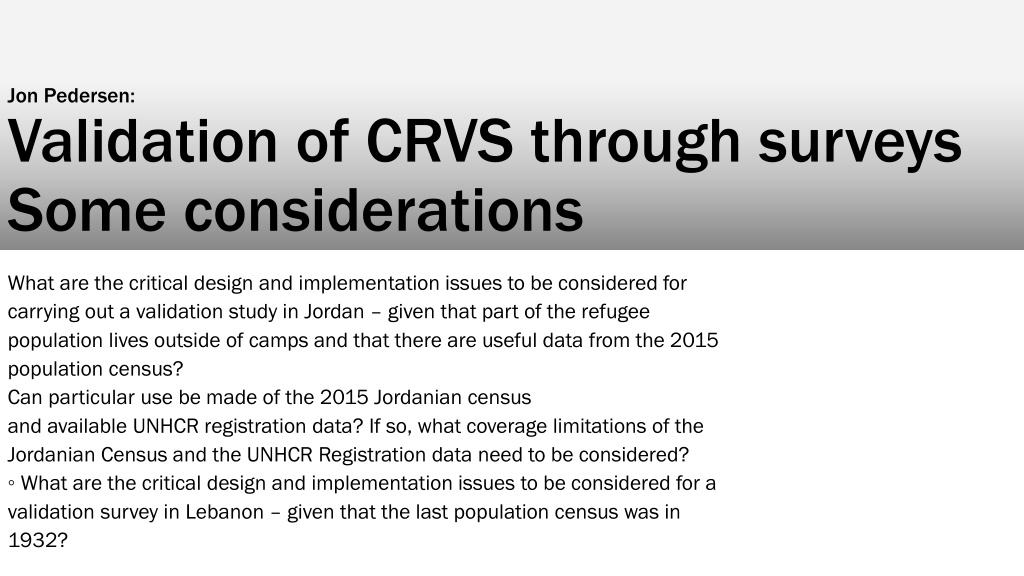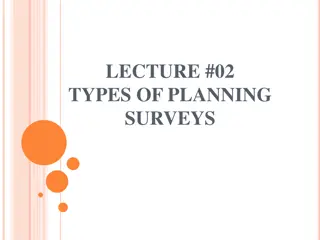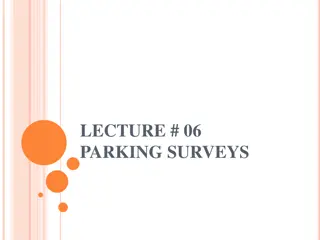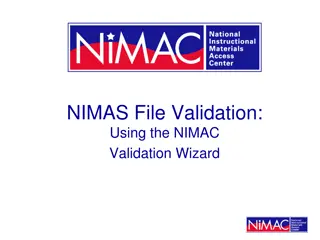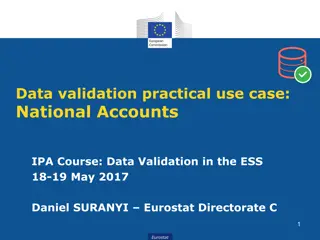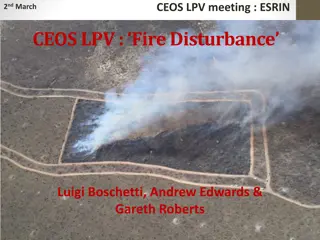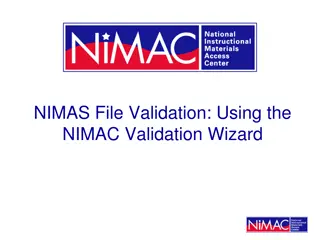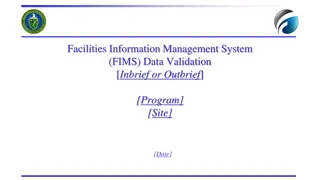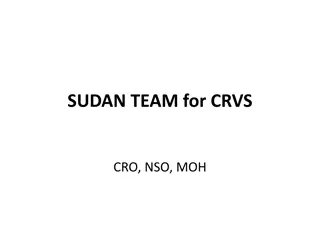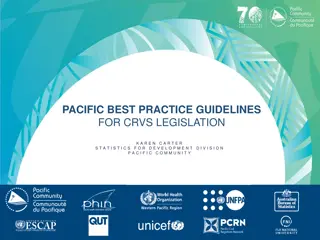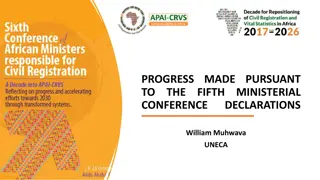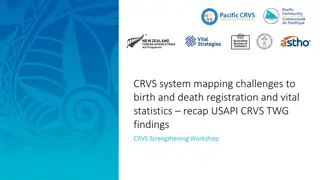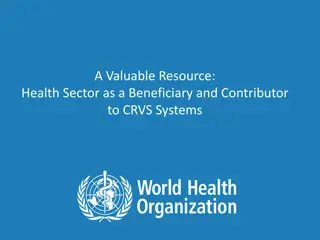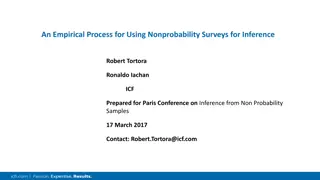Validation of CRVS through surveys Some considerations
Designing validation studies for Civil Registration and Vital Statistics (CRVS) in Jordan and Lebanon requires consideration of available data sources, coverage limitations, and survey methodologies. Challenges include validating CRVS data for refugee populations living outside camps, utilizing existing census and UNHCR registration data effectively, and addressing gaps in Lebanon's outdated census. Understanding the critical design and implementation issues is essential for conducting accurate validation surveys in these contexts.
Download Presentation

Please find below an Image/Link to download the presentation.
The content on the website is provided AS IS for your information and personal use only. It may not be sold, licensed, or shared on other websites without obtaining consent from the author. Download presentation by click this link. If you encounter any issues during the download, it is possible that the publisher has removed the file from their server.
E N D
Presentation Transcript
Jon Pedersen: Validation of CRVS through surveys Some considerations What are the critical design and implementation issues to be considered for carrying out a validation study in Jordan given that part of the refugee population lives outside of camps and that there are useful data from the 2015 population census? Can particular use be made of the 2015 Jordanian census and available UNHCR registration data? If so, what coverage limitations of the Jordanian Census and the UNHCR Registration data need to be considered? What are the critical design and implementation issues to be considered for a validation survey in Lebanon given that the last population census was in 1932?
Main issues in a validation survey What should be estimated and with what estimators? How can the target population be reached?
Possible estimators A CRVS reports events, that are supposed to be totals derived from a finite population Vital events of type t (deaths, deaths at age x, births etc) observed in CVRS (vt,c) vs vital events in population (vt,p) Thus, we would like vt,p vt,c= dt,cand dt,cshould be 0 We would expect the difference to vary between t (i.e. births could be OK, but not early neonatal deaths). We are sensitive to underreporting to varying degree If survey for validation, then what we are doing is ?t,p vt,c= dt,c ?t,pcan be estimated in various ways Simply as an Horwitz-Tomphson estimator ( ?t,p= ?=1 As a capture recapture type estimator (Petersen and so on) As an estimator based on some adaptive sampling scheme ?? ??) ?
Short aside on capture recapture (Large) survey carried out after CRVS enumeration. The two are then matched. In demography constructed differently than the typical capture recapture, but actually the same + = Typical CRVS survey table In CRVS Not in Total CRVS + ( )( N ) N D N C N 1 1 In survey N1 C D N1+D C+N2 1 Not in survey N2 corresponds to (i.e. Petersen estimator) N CM R Total N1+C D+N2 Total = Assumes a lot: 1. In CRVS Not in Total The population is closed There are no immigration or emigration, no deaths or births All have the same chance of being observed in the first sample Marking individuals does not affect their chance of being reobserved Individuals are reliably identified as having been observed before or not But possible to relax assumptions with more complex estimators (rather dramatic effects) CRVS In survey R C 2. Not in PES 3. Total M Total 4. Sometimes more complex modelling of each cell
Possible estimators: Derived Rate or ratios: Alternative to estimators of events Benefit: Intutively tells if the data makes sense Drawbacks Even if rates makes sense, there may be under-reporting of events May be difficult to interpret Survey derived rates are typically calculated differently than CRVS-derived ones (especially1q0and 5q0, Not a problem for births)
Possible estimators: secondary derived Proportion early neonatal to neonatal mortality vs IMR Calculation of diagnostic estimators from the rates (e.g. Proportion early neonatal of neonatal mortality) Benefit: May be quite revealing Drawbacks: Standards may be changing (and are only partly known) Variance 1.0 Proportion Early Neonatal to Neonatal 0.9 0.8 0.7 0.6 Mongolia Sweden Kazakhstan 0.5 12 14 16 18 20 22 IMR
Different situations for validation surveys Far from complete CRVS Nearly complete CRVS Target population is elusive (H2R) Main challenge lies in surveying elusive population Both elusive and sample size challenge Target population is standard Degree of non- completeness relatively easy to estimate Determining completeness requires large samples
Coverage of CVRS Vital events of type t (births, deaths, deaths at age x)observed in CVRS (vt,c) vs vital events in population (vt,p) Thus, we would like vt,p vt,c = dt,c and dt,c should be 0 We would expect the difference to vary between t. Alternatively we may express the differences as differences between rates or ratios, but: since CRVS rates differently constructed from survey based ones, difficult to do when CRVS is close to completeness (because difference in calculation method matters but simpler to focus on totals, i.e. the number of events themselves rather than estimators derived from them) Problem is estimating vital events in the population from a survey with Sufficent precision (sampling and measurement uncertainty) Lack of bias
Reaching the population: the examples of Jordan and Lebanon Jordan Easy part and difficult part: Camps, vs displaced outside camps 2015 census Surprising population size Good delineation of enumeration area cartography DoS traditionally not so good on actual listing within EAs. unclear why large number of migrants reported in census, as they are usually not covered well in surveys Traditional weak spot is work sites. For study of Iraqis in Jordan 2004 census was less informative in 2008 than envisaged, because of substantial movements of refugees Definition issue: who are refugees
Reaching the population: the examples of Jordan and Lebanon No census since 1932 CAS has prepared delination of EAs based on satelitte imagery, but getting old. Several polling firms have prepared their own (relatively) smalll area population estimates Overall proportion of migrants high (> 10%) Some geographic clustering of migrants Likely migration Some areas have security challenges Definition issue: who are refugees
Use of a census for sampling 101 a In principle, a census covers everyone within the borders of a country It defines small areas (containing typically 100 households or so) for the whole geographic extent It provides (recent) population figures for the small areas Therefore, nice to use for sampling because one can exploit the advantages of two stage cluster sampling with PPS in first stage and fixed sample take in second stage: ? ,?? ? ? ,?= , inclusion probability of cluster c within stratum h ? ,? ? ,?, inclusion probability of household f in cluster c in stratum h ? ,?,?= ? ,?? ? ? ,? ? ,?= ? ? ,? ? ,? =? ??That is, equal probabilities within strata. ? ,?= Thus no variance contribution from inclusion probabilities, and sample size fixed by design But reality is not quite like this ..
Use of a census for sampling 101 b Reality intervenes because household numbers in sampling cluster are not the same as they were in the frame (census), thus ? ,?? ? , inclusion probability of cluster c within stratum h (same as before) ? ,?= ? ,? ? ,? ?, inclusion probability of household f in listed cluster c in stratum h ? ,?,?= = That is, unequal probabilities within strata. ? ,?? ? ? ,? ? ,? ? ,?= ? Thus variance contribution from inclusion probabilities (1 + ??(1 still fixed by design, and sample is still unbiased ?)2), but sample size Note that accurate household numbers in frame are not necessary for an unbiased sample, but the less accurate, the more variance
Use of census for sampling 101 c Other aspects of reality are more important for lack of bias: If the delineation of enumeration areas exhausts all areas in the country, and there is a way to up-date the actual frame with enumeration areas that have become populated If there are procedures in place that ensures that everyone that actually resides in an enumeration area actually can be counted (i.e. how non-residental space is treated, informal housing etc)
Dealing with H2R (Elusivenes) Various methods Double sampling screening Disproportinate allocation not so good Adapative sampling Indirect sampling
Adaptive cluster sampling Used for populations that are rare, but clustered Some form of sample frame exists Procedure Select an ordinary cluster sample If a cluster contains more than z target respondents, choose all neighbours of that cluster. Continue selecting neighbours until cluster contains less than z target respondents For Easy /both procedure and estimation) Works well when clustered population assumption fulfilled Against Very rare populations -> no respondents Not so rare populations -> all clusters selected
Actually: Jordan and Lebanon are not so different Cartography Jordan has more accurate cartography, but CAS cartography in Lebanon not bad (but a bit old). Satellite images in Lebanon better for internal structure of EAs Population counts Question remains about Jordan s, probably not very good for migrants Lebanon: well. Migration likely to have messed up counts for population of interest. (note that we loose much of the benefit of our 101 description if we are interested in a sub group)
